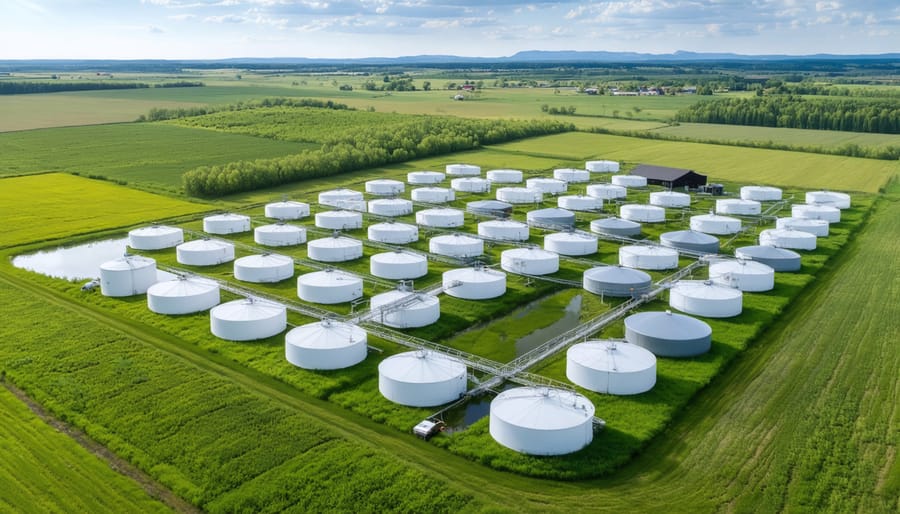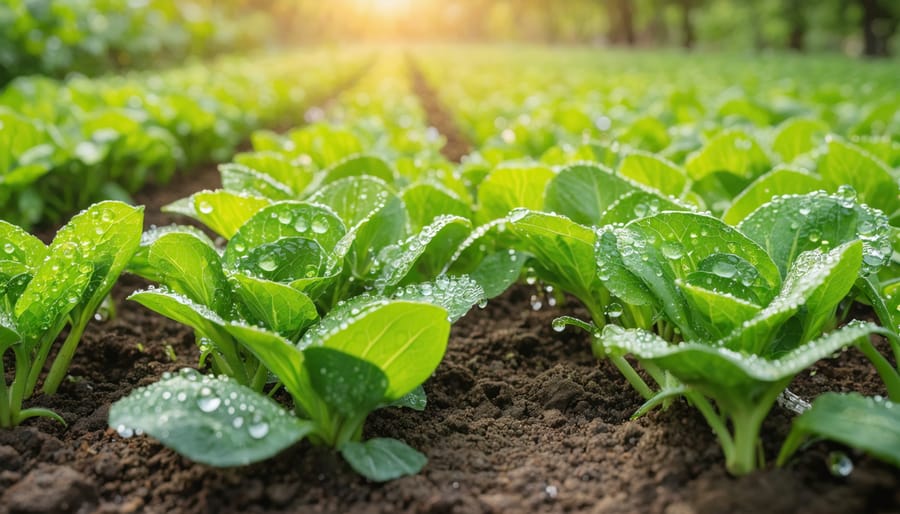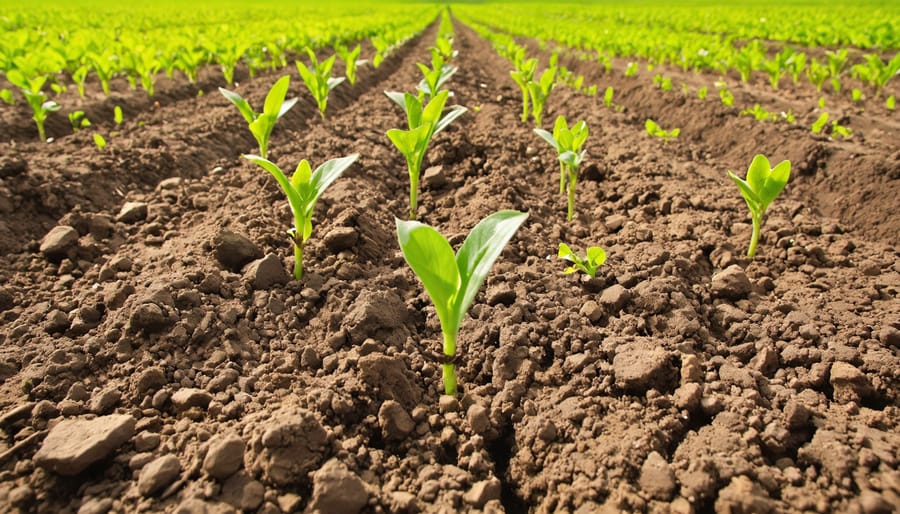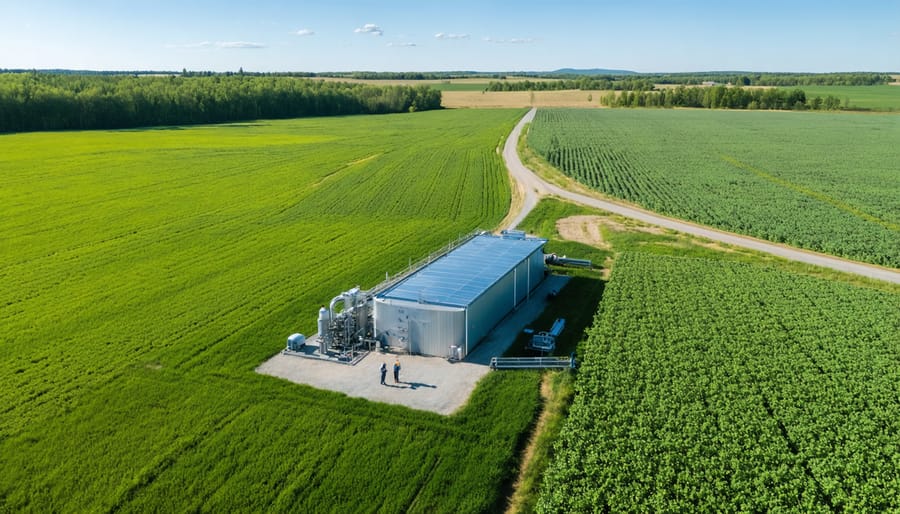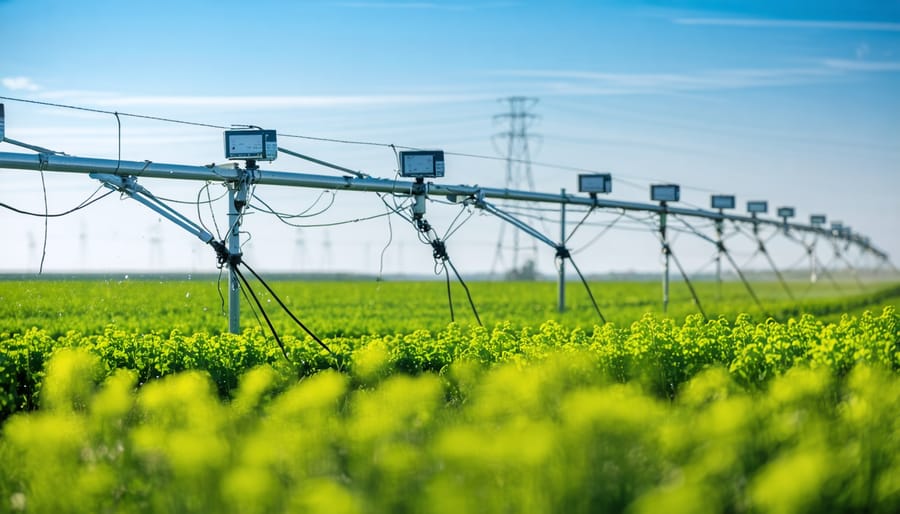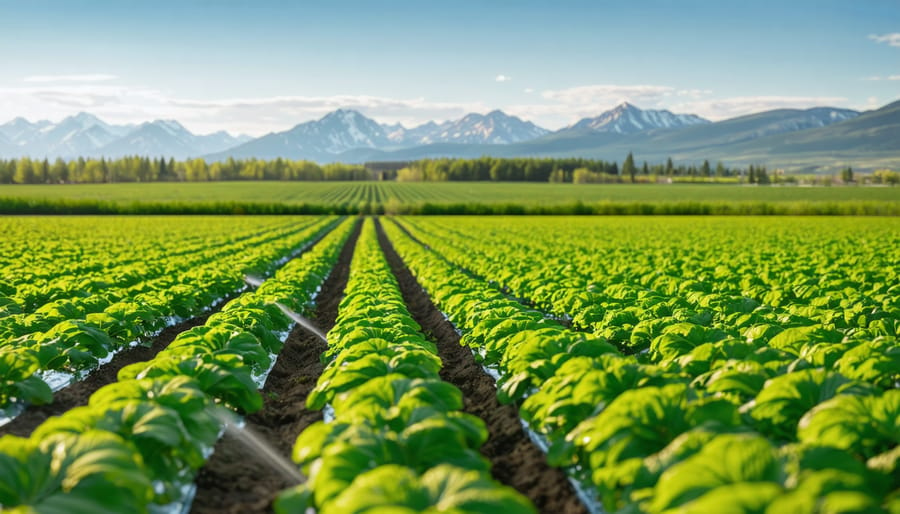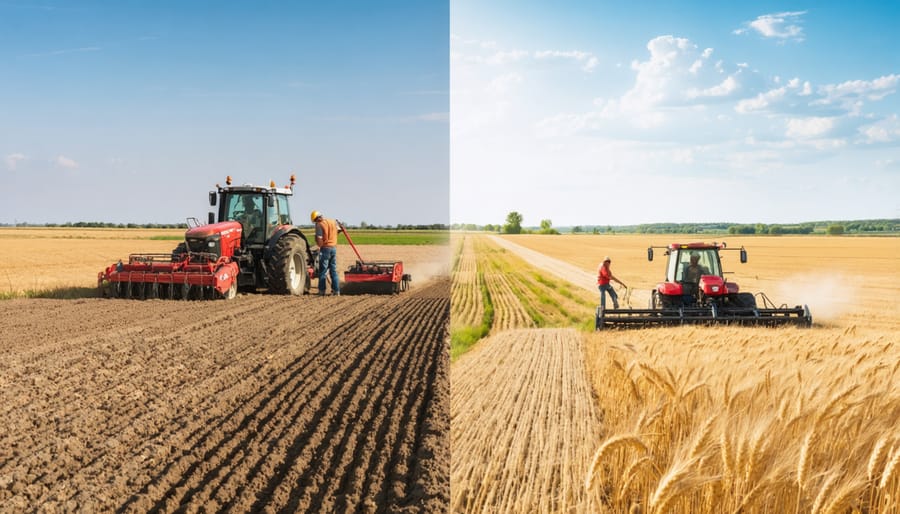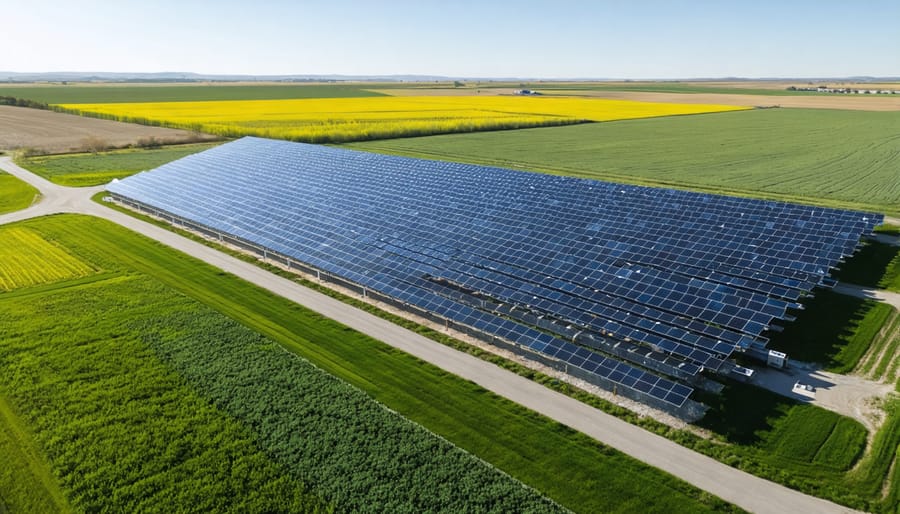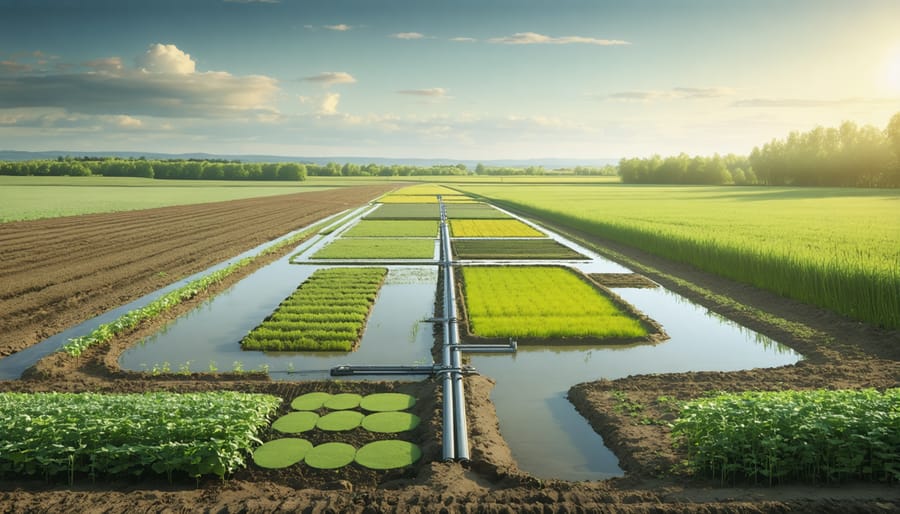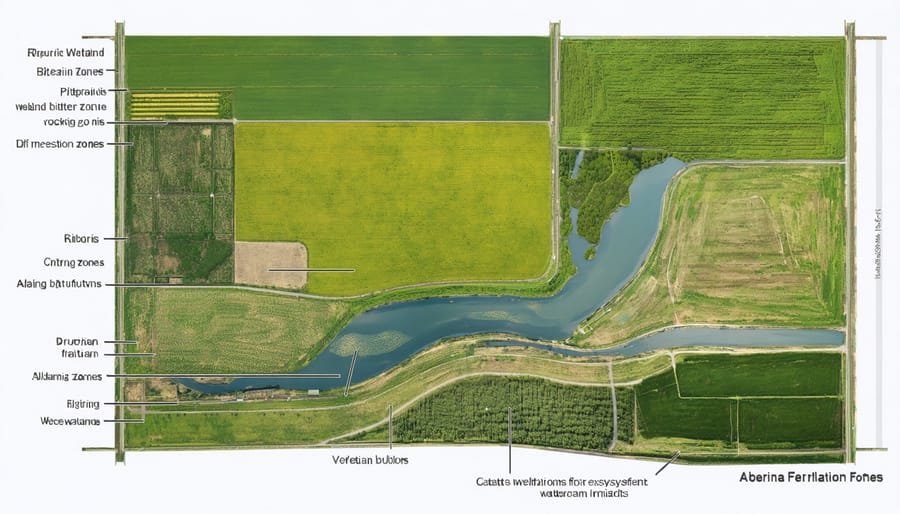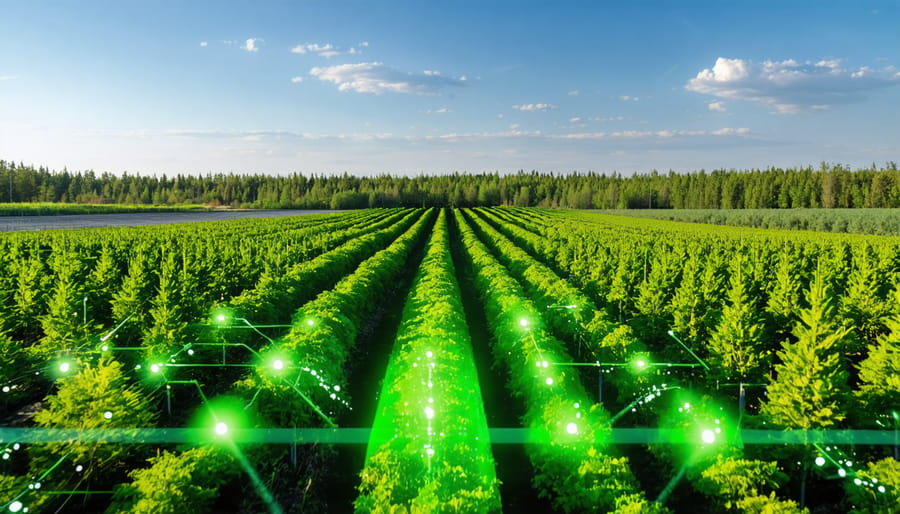Transform your farm’s water security by capturing, storing, and utilizing rainwater through strategically placed collection systems. As water scarcity challenges intensify across Alberta’s agricultural regions, rainwater harvesting emerges as a vital solution that reduces dependence on traditional irrigation while cutting operational costs by 30-40%.
Canadian farmers implementing these systems report harvesting up to 600,000 litres annually from a 1,000-square-meter roof area, providing critical moisture during dry periods and protecting crops against increasingly unpredictable weather patterns. By integrating storage tanks, filtration systems, and efficient distribution networks, modern rainwater harvesting transforms from an ancient practice into a sophisticated water management strategy that meets today’s agricultural demands.
This proven approach not only ensures sustainable water access but also improves soil health, reduces erosion, and provides cleaner water for livestock – all while meeting stringent Canadian agricultural standards. For Alberta’s farming community, rainwater harvesting represents not just a water conservation method, but a comprehensive solution for long-term agricultural resilience.
Why Alberta Farms Need Rainwater Harvesting Now
Current Water Challenges in Alberta Agriculture
Alberta’s agricultural sector faces growing challenges in water management, with annual precipitation patterns becoming increasingly unpredictable. Many farmers across the province report experiencing longer dry spells interspersed with intense rainfall events, making traditional irrigation planning more complex. Currently, the average farm in Southern Alberta requires approximately 300-400 millimetres of water annually for optimal crop production, yet some regions receive less than 280 millimetres of natural precipitation.
The pressure on existing water resources is intensifying, with irrigation districts managing limited allocations while serving a growing number of agricultural operations. According to recent Alberta Agriculture and Forestry data, over 60% of the province’s water consumption goes to agricultural use, primarily through traditional irrigation systems that can lose significant amounts to evaporation and runoff.
Local farmers are also dealing with rising water costs and stricter usage regulations. In areas like Lethbridge and Medicine Hat, where intensive farming operations are common, the competition for water resources between agricultural, industrial, and municipal users continues to grow. This situation has prompted many farmers to seek more sustainable and self-reliant water management solutions.
The Economic Case for Rainwater Collection
Investing in rainwater harvesting systems offers significant financial benefits for Alberta farmers, particularly when considering long-term water security. A typical 5,000-litre system costs between $2,500 and $4,000 to install, but this investment can pay for itself within 2-3 growing seasons through reduced municipal water costs and increased crop yields. Local farmer James Thompson from Red Deer County reports saving approximately $3,200 annually on irrigation costs after implementing a comprehensive water-saving strategies system that includes rainwater collection.
Beyond direct cost savings, rainwater harvesting provides insurance against drought periods, when water prices typically spike. The Alberta Agriculture and Forestry Department estimates that farms with rainwater collection systems are 40% more resilient to dry spells than those without. Additionally, government incentives and agricultural grants can offset initial installation costs by up to 30%, making the investment even more attractive. When factoring in the increasing frequency of drought conditions and rising water costs, rainwater harvesting represents a sound economic decision for forward-thinking Canadian farmers.
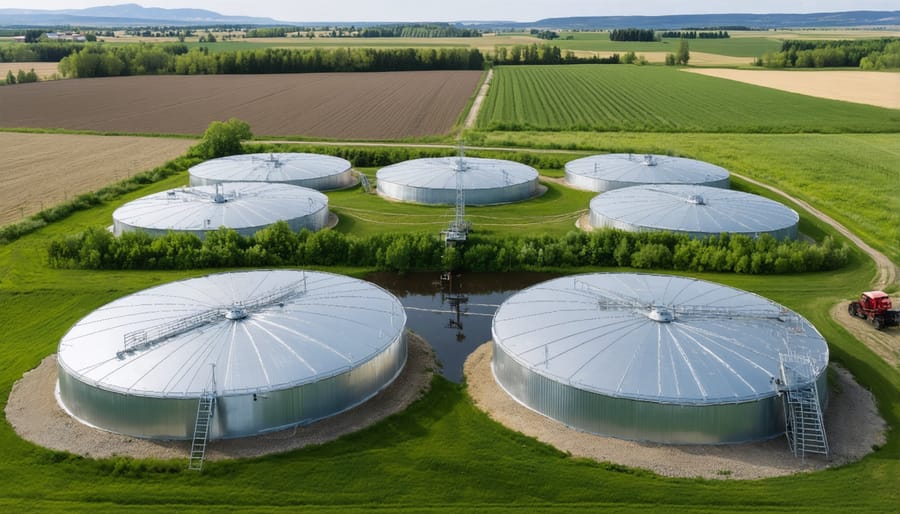
Practical Rainwater Collection Systems for Canadian Farms
Storage Solutions for Harsh Winters
When winter temperatures plummet in Alberta, protecting your harvested rainwater becomes crucial for year-round farming success. By implementing effective rainwater collection methods and proper storage solutions, you can maintain water quality and accessibility throughout the harsh Canadian winter months.
Underground storage tanks are particularly effective for winter storage, as they benefit from the earth’s natural insulation. Install tanks at least 2 meters below the frost line (typically 2.4 to 3 meters deep in Alberta) to prevent freezing. Ensure tanks are properly insulated with agricultural-grade foam materials and equipped with heating cables for additional protection.
Many Alberta farmers have found success using double-walled polyethylene tanks, which offer superior insulation and durability in extreme temperatures. These tanks can maintain water temperatures above freezing even when outdoor temperatures drop to -40°C. For above-ground storage, consider installing tanks in an insulated outbuilding or barn where ambient temperatures remain more stable.
Incorporate a circulation system to keep water moving, which helps prevent freezing and maintains water quality. Install temperature sensors and automated heating systems to monitor and maintain optimal storage conditions. Remember to drain external pipes and gutters before the first freeze and ensure all exposed components are properly winterized.
Local farmer Mike Thompson from Red Deer shares, “We installed our 50,000-litre underground system three years ago, and it’s been a game-changer for winter operations. The key is proper insulation and regular maintenance checks throughout the season.”
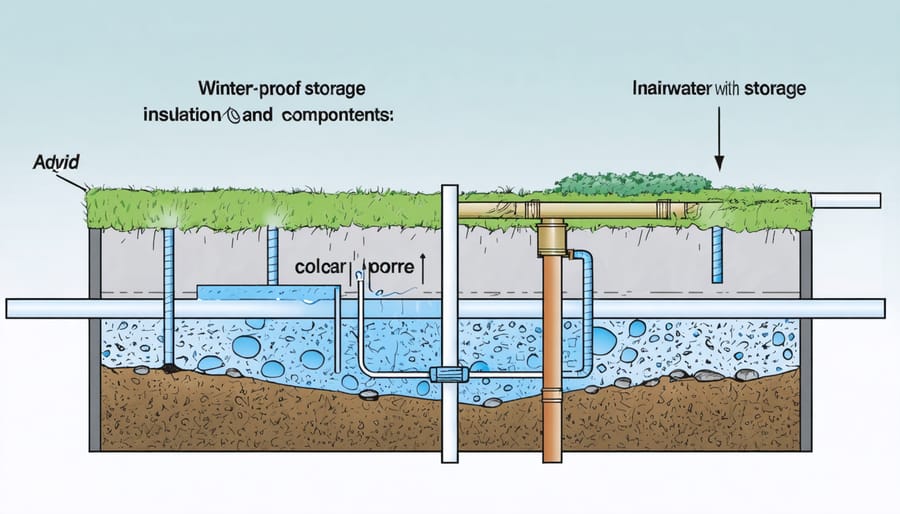
Distribution Systems That Work
Once you’ve collected rainwater, having an efficient distribution system is crucial for making the most of this valuable resource. In Alberta’s varied climate, a combination of gravity-fed and pressure-based systems typically works best for most farming operations.
For smaller operations, gravity-fed systems are cost-effective and reliable. By positioning storage tanks at elevated points, you can use natural water pressure to distribute water through irrigation lines. Many Prairie farmers have found success using elevated platforms or natural land features to achieve the necessary height difference.
Drip irrigation systems have proven particularly effective for row crops and orchards, delivering water directly to plant roots while minimizing evaporation. These systems typically use 30-50% less water than traditional sprinkler systems, making them ideal for our sometimes water-scarce regions.
For larger operations, pressure-based systems using energy-efficient pumps can provide consistent water delivery across larger areas. Solar-powered pumps have become increasingly popular among Alberta farmers, offering sustainable operation with minimal ongoing costs.
Zone-based distribution allows for targeted watering based on crop needs and soil conditions. By dividing your field into irrigation zones, you can customize water delivery through automated timers and moisture sensors. This approach has helped many local farmers reduce water usage by up to 25% while maintaining or improving crop yields.
Remember to include shut-off valves at key points and pressure regulators to prevent system damage. Regular maintenance checks, especially before winter, will help ensure your distribution system remains effective year after year. Consider installing filters to prevent debris from clogging distribution lines, particularly if you’re using drip irrigation.
Real Results: Alberta Success Stories

The Miller Farm Transformation
The Miller family farm, located just outside of Lethbridge, Alberta, transformed their 300-hectare operation through innovative rainwater harvesting techniques. In 2019, facing increasingly unreliable precipitation patterns and rising irrigation costs, Sarah Miller and her husband Tom decided to implement a comprehensive rainwater collection system.
Their system began with the installation of collection gutters on their main barn and equipment storage buildings, totaling 1,200 square metres of roof surface area. They connected these to a network of four 50,000-litre storage tanks, strategically positioned to maximize gravity-fed distribution to their fields.
The results were remarkable. Within the first year, the Millers collected over 150,000 litres of rainwater, reducing their reliance on traditional irrigation sources by 40%. The stored water proved particularly valuable during the dry spell of July 2020, when they maintained crop health while neighbouring farms struggled with drought conditions.
“The system paid for itself faster than we expected,” shares Sarah Miller. “We spent about $45,000 on the initial setup, including tanks and piping, but saved nearly $15,000 in water costs the first year alone.” The Millers also noted improved soil health in areas irrigated with rainwater, attributing this to the water’s natural pH balance and lack of added chemicals.
Their success has inspired five neighbouring farms to implement similar systems, creating a local network of sustainable water management practices.
Small-Scale Success: Urban Farm Applications
Urban farming operations across Alberta are proving that rainwater harvesting can be highly effective even in limited spaces. Take the example of Green Edge Urban Farm in Edmonton, which collects rainwater from their 200-square-metre greenhouse roof to support year-round vegetable production. Their simple system of gutters and storage tanks provides nearly 40% of their annual water needs.
In Calgary, the Community Garden Collective has implemented a shared rainwater harvesting system that serves 15 individual plot holders. Using a network of interconnected 1000-litre tanks, they capture spring melt and summer rains to maintain their diverse crops throughout the growing season. This collaborative approach has reduced their municipal water usage by 60% and strengthened community bonds.
Small-scale success isn’t limited to urban centres. The Rodriguez family farm, operating on just two acres outside Lethbridge, installed a basic rainwater collection system using repurposed IBC totes. They now harvest enough water to support their market garden operation, which includes high-value crops like tomatoes and leafy greens.
These examples demonstrate that size isn’t a limiting factor in rainwater harvesting success. With proper planning and scaled-appropriate systems, even modest operations can achieve significant water independence. The key is matching storage capacity to your specific needs and available collection area.
Implementation Guide: Getting Started
First Steps and Planning
Before diving into rainwater harvesting, careful planning is essential for success on your Alberta farm. Start by assessing your annual rainfall patterns and water needs throughout the growing season. Most Alberta farms receive between 300-500mm of annual precipitation, but this varies significantly by region and season.
Begin with a comprehensive site evaluation, considering factors like your property’s topography, soil type, and existing drainage patterns. Document areas where water naturally collects and flows during rainfall events. This information will help determine optimal collection points and storage locations.
Calculate your water requirements by examining:
– Crop water needs during peak growing periods
– Irrigation schedules
– Livestock requirements
– Processing and cleaning needs
Next, evaluate your available collection surfaces. Most farms utilize roof areas of barns, storage buildings, and other structures. A typical barn roof of 200 square meters can collect approximately 60,000 litres annually in central Alberta.
Consider how your rainwater harvesting system will integrate with existing soil and water conservation practices. This integration ensures maximum efficiency and sustainable water management across your operation.
Finally, research local regulations and permit requirements. Many Alberta municipalities have specific guidelines for agricultural water collection systems. Connect with your local agricultural extension office for guidance on compliance and available support programs.
Available Resources and Support
Canadian farmers looking to implement rainwater harvesting systems have access to numerous support channels and financial resources. The Canadian Agricultural Partnership (CAP) offers cost-sharing programs specifically for water management initiatives, with funding of up to 50% for eligible projects. In Alberta, the Environmental Stewardship and Climate Change Producer Program provides grants ranging from $2,000 to $100,000 for sustainable agriculture practices.
Local agricultural extension offices across Alberta offer free consultations and technical guidance. The Alberta Agriculture and Irrigation Knowledge Centre maintains a network of specialists who can assist with system design and regulatory compliance. Farmers can schedule on-site visits to assess their specific needs and receive tailored recommendations.
Several non-profit organizations, including the Land Stewardship Centre and ALUS Canada, provide additional funding opportunities and technical support. The Agriculture Financial Services Corporation (AFSC) offers low-interest loans specifically for water management infrastructure improvements.
For hands-on learning, the Alberta Farm Water Supply Assistance Program conducts regular workshops and demonstration events throughout the province. These sessions connect farmers with experienced practitioners and equipment suppliers. The Prairie Farm Rehabilitation Administration maintains an online resource library with detailed guides, case studies, and planning tools specific to Canadian farming conditions.
Local watershed groups and conservation authorities can also provide valuable insights about regional water management practices and potential collaboration opportunities with neighboring farms.
As we’ve explored throughout this article, rainwater harvesting presents a viable and sustainable solution for Canadian farmers looking to enhance their water security and agricultural productivity. By implementing these systems, Alberta farmers can capture an average of 55,000 litres of water per 100 square metres of collection area annually, providing a significant supplement to traditional water sources.
The benefits we’ve discussed – from reduced water costs and increased crop resilience to environmental stewardship and improved soil health – make a compelling case for adoption. Many of our featured Alberta farmers have reported up to 30% reduction in their conventional water usage after implementing these systems, while simultaneously improving their crop yields.
Taking the first step toward rainwater harvesting doesn’t have to be overwhelming. Start small with a basic collection system and expand as you become more comfortable with the technology. Remember that local agricultural extension offices and farming communities are valuable resources for guidance and support.
Consider reaching out to fellow farmers who have already implemented these systems. Their practical experience and insights can be invaluable as you begin your own rainwater harvesting journey. With changing climate patterns affecting traditional water sources, now is the perfect time to invest in this sustainable farming practice.
By working together and sharing our experiences, we can build a more resilient and sustainable agricultural future for Alberta and beyond. Take that first step today – your farm, your community, and future generations will thank you.

